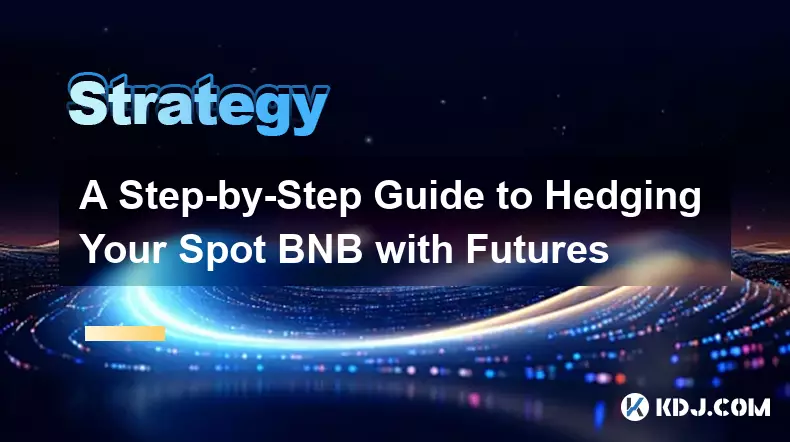-
 bitcoin
bitcoin $114206.058833 USD
-0.82% -
 ethereum
ethereum $4129.796871 USD
-1.31% -
 tether
tether $0.999964 USD
0.00% -
 xrp
xrp $2.640265 USD
-0.68% -
 bnb
bnb $1141.700384 USD
-0.18% -
 solana
solana $200.380665 USD
-2.05% -
 usd-coin
usd-coin $0.999888 USD
0.01% -
 dogecoin
dogecoin $0.200706 USD
-3.43% -
 tron
tron $0.299112 USD
-0.60% -
 cardano
cardano $0.668491 USD
-2.72% -
 hyperliquid
hyperliquid $46.924669 USD
-2.72% -
 chainlink
chainlink $18.286013 USD
-2.66% -
 bitcoin-cash
bitcoin-cash $555.734639 USD
-0.58% -
 stellar
stellar $0.323999 USD
-2.74% -
 ethena-usde
ethena-usde $0.999169 USD
0.00%
A Step-by-Step Guide to Hedging Your Spot BNB with Futures
Hedging BNB involves offsetting spot holdings with a short futures position, matching value to neutralize price risk while monitoring funding rates and margin.
Oct 27, 2025 at 02:18 pm

Understanding the Basics of Spot and Futures Markets
1. Spot markets involve the immediate exchange of assets, such as BNB, at current market prices. When you hold BNB in your wallet, you are exposed to price fluctuations based on real-time supply and demand.
2. Futures contracts, on the other hand, allow traders to agree on a price today for buying or selling an asset at a future date. These instruments are commonly used to hedge against adverse price movements.
3. By taking an opposing position in the futures market relative to your spot holdings, you can offset potential losses if the price of BNB declines. For example, holding BNB in spot while shorting BNB futures creates a temporary neutral exposure.
4. The key is ensuring that the size of your futures position matches the value of your spot holdings to maintain a balanced hedge. Misalignment could result in over-hedging or under-hedging, both of which carry risks.
5. It’s essential to monitor funding rates when using perpetual futures contracts, as these periodic payments can erode profits or increase costs over time, especially during prolonged hedging periods.
Setting Up Your Hedging Strategy
1. Begin by calculating the total value of your BNB holdings in USD or another stable reference. This will determine the size of the futures position needed to effectively hedge your exposure.
2. Choose a reliable exchange that offers deep liquidity in BNB futures, such as Binance or Bybit. High liquidity ensures tighter spreads and reduces slippage when entering or exiting positions.
3. Decide whether to use quarterly futures or perpetual contracts. Perpetuals offer flexibility but come with ongoing funding fees; quarterly futures have fixed expiration dates but avoid recurring costs.
4. Open a short futures position equivalent to your spot BNB value. If you hold $10,000 worth of BNB, short $10,000 worth of BNBUSD futures to establish the hedge.
5. Use limit orders to enter the futures position to avoid unfavorable pricing. Market orders may execute at worse rates during volatile conditions, undermining the effectiveness of your hedge.
Managing Risk During the Hedge
1. Maintain sufficient margin in your futures account to withstand price swings. Even if your spot and futures positions offset each other, the futures leg is subject to liquidation if not properly margined.
2. Monitor open interest and volume trends in BNB futures to gauge market sentiment and potential volatility shifts. Sudden spikes may signal increased risk and require adjustments to your position sizing or stop-loss levels.
3. Consider setting up conditional orders, like take-profit or stop-market triggers, to automatically manage the futures side if the market moves sharply against your expectations.
4. Be aware of event-driven risks such as exchange announcements, regulatory news, or macroeconomic data that could trigger sudden BNB price moves, impacting both spot and futures legs simultaneously.
5. Regularly rebalance your hedge if the value of your spot BNB changes significantly due to price movement or additional purchases/sales. A drifting hedge loses its protective function over time.
Unwinding the Hedge Safely
1. Determine the endpoint of your hedging need—this could be after a major announcement, technical upgrade, or market correction period. Clarity on timing helps prevent holding unnecessary positions.
2. Close the short futures position before or at the same time as selling your spot BNB. Leaving the futures leg open after disposing of spot exposes you to directional risk in the opposite direction.
3. Always verify that both legs of the trade have been settled correctly by checking your transaction history and account balances post-exit. Discrepancies can lead to unintended exposures or accounting errors.
4. Account for any funding payments made or received during the hedge duration when evaluating overall performance. These costs affect net results even if the hedge was directionally accurate.
5. Document the entire process—from setup to exit—for future reference. This improves decision-making in subsequent hedging activities and supports tax reporting where applicable.
Frequently Asked Questions
What happens if I don’t close my futures position after selling my spot BNB?Leaving the futures position open turns it into a speculative short bet on BNB. Without the offsetting spot holding, you’re fully exposed to price increases, which could lead to significant losses if the market rises.
Can I hedge partial BNB holdings instead of the full amount?Yes, you can hedge a portion of your holdings to reduce exposure without eliminating it entirely. This approach is useful when expecting moderate downside but still wanting to benefit from potential upside.
How do funding rates impact my BNB futures hedge?If you're shorting BNB perpetuals, you may receive funding payments in bullish markets or pay them in bearish ones. Over time, these flows influence the cost-efficiency of maintaining the hedge.
Is cross-margin safer than isolated margin for hedging?Cross-margin uses your entire account balance as collateral, reducing liquidation risk but exposing all funds to potential loss. Isolated margin limits risk to a defined amount but requires precise management to avoid early liquidation.
Disclaimer:info@kdj.com
The information provided is not trading advice. kdj.com does not assume any responsibility for any investments made based on the information provided in this article. Cryptocurrencies are highly volatile and it is highly recommended that you invest with caution after thorough research!
If you believe that the content used on this website infringes your copyright, please contact us immediately (info@kdj.com) and we will delete it promptly.
- Essex Post Office, 5p Coins, and King Charles: A Royal Mint Revelation!
- 2025-10-23 10:30:16
- Waymo's Newark Airport AV Tests: Alphabet's AI Gamble Pays Off?
- 2025-10-23 10:30:16
- King Charles 5p Coins: A Royal Flush in Your Pocket?
- 2025-10-23 10:35:18
- Solana, Crypto Advisory, and Forward Industries: A New York Minute on the Future of Finance
- 2025-10-23 08:51:22
- MAGACOIN: Ethereum Whales Dive into the Hottest Presale of 2025
- 2025-10-23 08:51:22
- Kadena's End of the Road? KDA Token Plummets Amid Project Abandonment
- 2025-10-23 08:55:34
Related knowledge

A Simple Strategy for Scalping Ethereum (ETH) on the 5-Minute Chart
Oct 25,2025 at 01:54pm
A Simple Strategy for Scalping Ethereum (ETH) on the 5-Minute Chart This strategy focuses on short-term price movements of Ethereum using a 5-minute t...

A Beginner's Guide to Setting Up a Leveraged Ethereum (ETH) Grid Bot
Oct 27,2025 at 03:36pm
Understanding the Basics of a Leveraged ETH Grid Bot1. A leveraged Ethereum grid bot is an automated trading strategy designed to profit from price fl...

A Step-by-Step Guide to Hedging Your Spot BNB with Futures
Oct 27,2025 at 02:18pm
Understanding the Basics of Spot and Futures Markets1. Spot markets involve the immediate exchange of assets, such as BNB, at current market prices. W...

A Guide to Trading Avalanche (AVAX) Perpetual Contracts for Beginners
Oct 25,2025 at 11:36pm
Understanding Avalanche (AVAX) Perpetual Contracts1. Perpetual contracts are a type of derivative product that allows traders to speculate on the pric...

How to Reduce Liquidation Risk on a High-Leverage BNB Position?
Oct 25,2025 at 05:36pm
Understanding Liquidation Mechanics in High-Leverage BNB Trading1. Liquidation occurs when the value of a leveraged position drops to a level where th...

How to Day Trade Bitcoin (BTC) Futures: A Complete Guide
Oct 28,2025 at 12:24am
Understanding Bitcoin Futures and Their Market Mechanics1. Bitcoin futures are derivative contracts that allow traders to speculate on the future pric...

A Simple Strategy for Scalping Ethereum (ETH) on the 5-Minute Chart
Oct 25,2025 at 01:54pm
A Simple Strategy for Scalping Ethereum (ETH) on the 5-Minute Chart This strategy focuses on short-term price movements of Ethereum using a 5-minute t...

A Beginner's Guide to Setting Up a Leveraged Ethereum (ETH) Grid Bot
Oct 27,2025 at 03:36pm
Understanding the Basics of a Leveraged ETH Grid Bot1. A leveraged Ethereum grid bot is an automated trading strategy designed to profit from price fl...

A Step-by-Step Guide to Hedging Your Spot BNB with Futures
Oct 27,2025 at 02:18pm
Understanding the Basics of Spot and Futures Markets1. Spot markets involve the immediate exchange of assets, such as BNB, at current market prices. W...

A Guide to Trading Avalanche (AVAX) Perpetual Contracts for Beginners
Oct 25,2025 at 11:36pm
Understanding Avalanche (AVAX) Perpetual Contracts1. Perpetual contracts are a type of derivative product that allows traders to speculate on the pric...

How to Reduce Liquidation Risk on a High-Leverage BNB Position?
Oct 25,2025 at 05:36pm
Understanding Liquidation Mechanics in High-Leverage BNB Trading1. Liquidation occurs when the value of a leveraged position drops to a level where th...

How to Day Trade Bitcoin (BTC) Futures: A Complete Guide
Oct 28,2025 at 12:24am
Understanding Bitcoin Futures and Their Market Mechanics1. Bitcoin futures are derivative contracts that allow traders to speculate on the future pric...
See all articles










































































